Neanderthal environmental bio-advantages and their socio-culturel effects
Humans living in caves: health advantages 3/3
by Amanda Laoupi
Rock shelters and caves, apart from their ecological and environmental value, have played a prominent role in the study of man’s adventure on Earth. From Palaeolithic times onward, humans have used, worldwide, these geological formations for a variety of reasons, as residence, animal pen/shelter, work/production place, water source, storage place, mine/quarry, dump, burial place, sacred place, ceremonial place, tourist site, place of execution/disposal of bodies, refuge from danger, refuge for outlaws/resistance fighters, refuge for cast-outs/victims of epidemics, and as scientific destination.
Nowadays, cave formations are acknowledged to be a vivid part of human heritage. To “cultural heritage” can be assigned any kind of evidence related to human action, any ‘product’ of human creativeness and expression, widely accepted for its scientific, historic, artistic and anthropological value. On the other hand, natural landscapes are also included in the lists of patrimony objects that must be protected.
Equally important is the scientific role of the caves, because they function as ‘archives’ of past environmental changes, providing Disaster Archaeology with valuable data/information in order to detect hazardous phenomena, climatic oscillations and other natural perturbations that took place thousands, even millions of years ago.
Especially the finger fluting (term coined by Robert Bednarik in 1986), a form of prehistoric rock art in caves from Australia and New Guinea to Europe, are generally made in a substance called moonmilk, through a thin clay film into moonmilk underneath or sometimes just into clay (Breuil, 1952; Sharpe & Van Gelder, 2006 and 2006b).
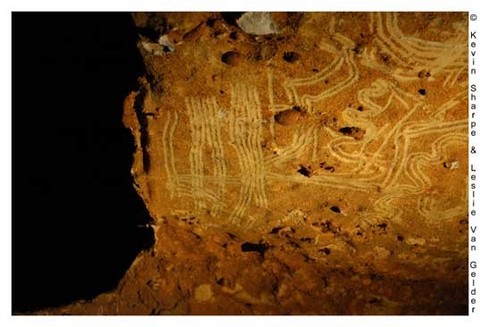
Flutings at the start of the 150 sq m Desbordes Panel, Chamber A1, Rouffignac Cave, France. Image credit: Sharpe & Van Gelder, own work, 2007. CC BY 2.5.
https://en.wikipedia.org/wiki/Finger_fluting#/media/File:RouffignacFlutings.jpg
When microbes and mud in caves are combined, they form the moonmilk (a very fine white material; not a mineral, but a speleothem; it is usually composed of carbonate minerals but may also be composed of sulphates – e.g. gypsum - phosphates, silicates and other minerals). More precisely, the historical term Mondmilch (calcite moonmilk) is related to the proper type locality, the cave Mondmilchloch from South-Pilatus near Lucerne (Switzerland).
Fischer (1988) defines Mondmilch stricto sensu (>90% CaCO3) in order to distinguish mondmilch-like carbonate speleothems (= moonmilk, <90% CaCO3) and other subterranean deposits, e.g. sulphates, phosphates and silicates from pure calcite Mondmilch (see also: Moore & Sullivan, 1997).
European peasants used moonmilk for centuries to heal infected cuts in livestock, because due to its probiotic, anti-inflammatory and antibiotic properties, it kills infections and speeds healing at rates highly beyond normal. Much of the calcite moonmilk sampled by investigators contains actinomycetes, which are the main producers of antibiotics. Actinomycetes are gram-positive organisms, mostly aerobic, a subdivision of the Procaryotae Kingdom. Since they had been first regarded as fungi, they received their name from the two Greek words: actino- (ray) and mycete (mushroom). They occur in soil, being especially important in the production of humus, giving to it its characteristic “earthy” aroma; they produce streptomycin. In the 1940’s, Selman A. Waksman (Nobel prize laureate 1952 - California University), along with his students, isolated more than fifteen antibiotics, one of which was the Tuberculosis antibiotic streptomycin, the first effective treatment for this deadly disease aka the White Plague (Waksman, 1952 & 1954). In 2009, in USA, there have been produced about 166 antibiotics and derivatives based on actinomycetes’ action (Mahajan & Balachandran, 2012).
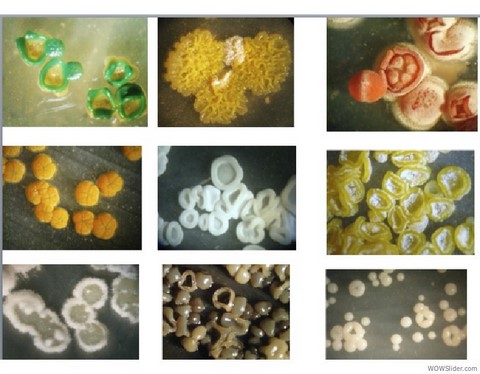
xImages of Actinomycetes (soil bacteria) colonies isolated on media,
as viewed under a microscope. Image credit: https://fhs.mcmaster.ca/main/news/news_2013/antibiotic_drug_discover_method/index.html
Moonmilk has been used also as a wound dressing and cavers affected by colds report their cold symptoms disappearing underground (see the online article of The Siberian Times, May 6 -2016: Lake Baikal ‘holds key to new advances in antibiotics’ < http://siberiantimes.com/home/we-say/lake-baikal-holds-key-to-new-advances-in-antibiotics/?comm_order=best>).
Moreover, specific caves produce specific forms of it, e.g. Calcite moonmilk can contain such bacteria as Macromonas bipunctata, along with cyanobacteria, fungi, and green algae, all assisting in breaking down minerals in the wall rock and adding them to the moonmilk (Roth, 2005). Ancient medical texts reported that moonmilk had therapeutical properties, thereby suggesting that it might be a source of natural products useful in human treatment (Hill & Forti, 1997; Northup & Lavoie, 2001; Frontiers of Karst Research: Proceedings and recommendations, 2007; Maciejewska et al., 2016).
On the other hand, cave dwellers (in karstic environments, igneous rocks, salt formations, crystal formations, etc) seem to have enjoyed three advantages from the standpoint of comfort: stable ambient diurnal temperature, stable light-dark cycle affecting a normal hormonal biorhythm, and relative humidity in contrast to the seasonal outdoors, especially during climatic phases when temperature extremes were the norm (see a general but usefully navigating webpage for the effects of climate on human health as monitored and based on modern data: <http://www.ciesin.org/docs/001-338/001-338.html>). The earth that surrounds a cave insulates and retains the heat. Thus, the benefits of this stable atmosphere refer to the physiological functions of temperature regulation and metabolism. Huo Yan (Huo Yan, 1986; Golany, 1992: 125) summarizes the health benefits of cave dwellers, e.g. reduction of upper respiratory infection incidents and rheumatism. From Homo erectus pekinensis and Neanderthals to Homo sapiens sapiens, our prehistoric ancestors all benefited from cave environments, as archaeological research has proven worldwide.
Furthermore, when one lives in a cave, he/she feels like being in a womb, very safe, comforted and protected. He/she feels connected to the cave and he/she feels it like a living organism. The thick rock ceiling casts out most of the harmful cosmic radiation. The air in caves is rarely stagnant and the negative ions of the inner atmosphere (usually oxygen atoms that gained an electron) combat the effect of free radicals leaving a relaxing sensation. Like being near the ocean or immediately after a storm, the air charged with negative ions suppresses serotonin within the body, boosting high energy levels and good mood. In addition, it helps with insomnia problems even on manic patients. The mineral-infused air within the cave helps human organisms to replace mineral loss which leads to mineral deficiency and eventually to many chronic illnesses. The isolation from outside noise and light soothes the circadian rhythms and equilibrates daily stress in the outside world. Apart from biological benefits, the spiritual/emotional benefits are also very powerful.
To sum up, modern research (e.g. the 1987 study in Biological Psychiatry and the 1993 research of Reilly & Stevenson; Silvestru, 2008) recognizes a plethora of advantages in negative-charged air (in contrast with air-conditioning systems, TV and others of today’s electro-environments): it increases the sense of well-being, focus and mental clarity; it improves the function of cilia in the respiratory tract; it protects the lungs from irritation and inflammation; it normalizes breathing; it relaxes and decreases blood pressure by relieving stress and tension; it relieves from depression and Seasonal Affective Disorder; it increases energy levels by normalizing the neurotransmitter serotonin levels in the brain; it improves mood and sleep; it reduces headaches and decreases instances of sickness; it boosts the immune system.
Even more, caves can – and have – been used for therapeutic reasons (Speleotherapy: a special form of climatotherapy discovered in Poland in 1843). Caves being ambiguous spaces, offer both protection and shelter, but can also trap and imprison. The cave as a spiritual landscape, acts like ‘interiority’. Its direction is inward, but it is also down and the cave journey involves ‘getting down’. The heart, womb, and cauldron are all inward, earthy spaces. As such, they involve directness toward the core and away from the periphery, toward depth and away from the surface, toward concentration and away from dispersion (Laoupi, 2007: Levy, 1963; Eliade, 1964 & 1972; Sjoo & Mor, 1987). Thus, being an oasis of calm and healing, they enhance togetherness and the sense of private space. Although sacredness may have been invested in many other natural forms and objects, during Prehistoric Times, the earliest known sacred places where shamanic initiations took place were naturally-formed caves.
Moreover, labyrinths appear in various countries throughout the world as a strong symbolic archetype (Laoupi, 2017). This mystical symbol is at once the universe, the individual life, the temple, the town, human existence, the cave/womb or innards of Mother Earth as its counter-image, the convolutions of the brain, consciousness, the heart, the pilgrimage, the journey and the way. In its duality, it is the cosmos to those who know the way, and chaos to those who lose it. It is Ariadne's thread, whose windings create the world and yet enable us to unravel it or ravel it... This symbolic ‘conjunctio oppositorum’ is the place where opposites such as life/death, light/dark, male/female are transformed and melt into each other, in the dance of the spiral (Laoupi, 2007: Matthews, 1985; Freitas, 1987: 413; Gimbutas, 1989; Savard, 2003).
The famous Cretan labyrinth had been a dancing ground made for Ariadne rather than for Minos (Hom. Il. 18.590 - 593). ‘Homer compares the dance worked by Hephaistos on the shield of Achilleus to a dance made by Daidalos, because he had never seen more clever workmanship’ (Paus. Guide of Greece 8.16.3). The paths in the maze are dances that are performed by the participants in the ceremony. These dances show that though many paths are taken, and some are a dead-ends, life continues through. This is the key of the Dionysian rituals, Dionysos being Ariadne’s immortal husband (Laoupi, 2007: Kerenyi, 1996). In the original story, Ariadne was a Goddess who provided guidance through the mysterious temple maze of ancient Crete, where she presided as priestess. Her famous spiral-like thread helped seekers to find their way safely in and out. The real hero is one who can keep hold of the labyrinth's thread, not fearing it, but following it to find self-actualization, spiritual rebirth and love. Another version of the story of Ariadne makes her a Goddess and lover, but also a destroyer. The labyrinth is her womanly cycle, the cave her womb and the Minotaur her heart. Therefore, the traveller of the labyrinth learned lessons of ecstasy, transformation and immortality (Laoupi, 2007: Farrar, 1987; Mountainwater, 1991).
The ‘craddle’ of the pristine cosmovision was the cave. A large number of archaeologists and historians of religion claim that Shamanism may have been a dominant religious practice for humanity during the Palaeolithic. In fact, recent archaeological evidence suggests that the earliest known shamans, dating to the Upper Palaeolithic, were women, exhibiting a two-spirit identity. On the other hand, as being the primary teacher of tribal symbolism, the shaman may have a leading role in this ecological management of local societies. He/she actively restrict hunting and fishing, and is able to ‘release’ game animals, or their souls, from their hidden abodes (Laoupi, 2016: Kleivan and Sonne, 1985; Merkur, 1985; Reichel-Dolmatoff, 1997; Price, 2001; Vitebsky, 2001; Eliade, 2004; Tedlock, 2005; Harvey & Wallis, 2007; McDonald & Veth, 2012; Pitulko, et al., 2012; Winkelman, 2013).
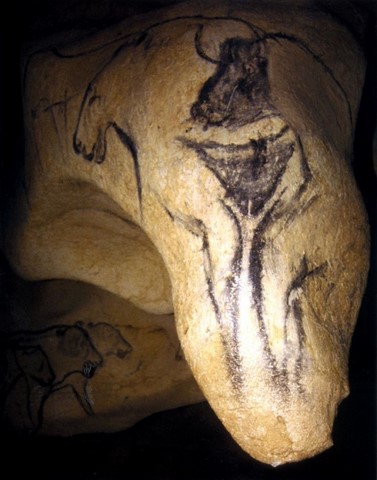
Chauvet Cave (Ardèche, southern France). Salle du Fond (the last and deepest of the chambers), nearly 7m high. A vertical cone of limestone hangs down ending in a point 1.10m off the floor. The Venus (pubic triangle) and the Sorcerer (man-bison) are drawn in black charcoal.
Evidence suggests that the Venus is Aurignacian, created in the first period of the decoration of the Cave (ca 32 to 30 kya). The ‘Bull-Vulva’ motif led Curtis (2006) to interpret this composite drawing as the representation of the ‘Minotaur’. See: Laoupi, 2017.
Many ‘otherworldly’ clues of Paleolithic rock art have also led archaeologists and anthropologists to believe that primitive artists were in a hallucination/trance status when they created the paintings; a theory reinforced by the presence of two gases, CO2 (Carbon Dioxide) and Rn (Radon), in caves, apart from other hallucinogenic substances (Hopman, 2008;’ Froese et al., 2013).
In parallel, the evolution of the human brain as seen through the lenses of Palaeolithic Rock Art is a fascinating, intriguing and breath-taking issue that covers a broad range of scientific fields, interdisciplinary research, hot debates and much extended bibliography (e.g. the experiment of London psychiatrist Dominic H. Ffytche starting in 2007; Ramachandran, 2012; Janik, 2013; Chatterjee, 2015; International Network for Neuroaesthetics: < https://neuroaesthetics.net/tag/cave-art/>; Neuroaesthetics. A bibliography: <https://fergus.wordpress.com/2006/09/27/neuroaesthetics-a-bibliography/ >; Art in the Embodied Mind. A Bibliography:<https://www.researchgate.net/publication/312320657_Embodied_cognition_and_aesthetic_experience_a_bibliography >; Rock-Art database: < http://www.rockartdatabase.com/v2/ >).
The human brain is the most complex organ known in the humanly observable universe. A very intriguing, hotly debated, though, perspective is, also, the Bicameralism in Psychology, a term coined by the psychologist Julian Jaynes (1976), according to which the human brain, at least 3 Ka and beyond, was in a state in which cognitive functions were divided between one part of the brain which appears to be ‘speaking’, and a second part which listens and obeys. This mind experiences the world similarly to the schizophrenic mentality without making conscious evaluations in novel or unexpected situations. The regions responsible for this mentality (right temporal lobe) are somewhat dormant in the right brains of most modern humans. His interdisciplinary approach uses many trans-cultural examples such as music, poetry and myths in ancient Greece and the Old Testament. On the contrary, the cognitive functions of introspection, self-consciousness and dream analysis is present in the Epic of Gilgamesh and in the Odyssey. The bicameral minds of the ancients were strongly and violently tested by extreme environmental conditions (e.g. earthquakes, plagues, droughts and climatic changes), severe catastrophes and socio-cultural upheaval (e.g. migrations). Consequently, consciousness (self-awareness, flexibility, creativeness, language as necessary component of subjective consciousness, etc), like bicamerality, emerged as a neurological adaptation to social complexity in a changing world. Today, the concept of the need for external authority in decision-making (bicameralism) survives in religious prophecies and rituals (as the majority of the world’s cultures encourage or require members to enter alternative states of consciousness/ASC), hypnosis, states of possession and schizophrenia (Laoupi, 2016: Siegel and West, 1975; Lewis-Williams, 2002; Shanon, 2002; Huxley, 2004; Lewis-Williams and Pearce, 2005; Hodgson, 2006; Hodgson and Helvenston, 2006; Kuijsten, 2007 & 2012).
The ancient lore, the primitive thought, the pristine knowledge of humankind, especially in times of chaos and change, are the key element of Shamanism in the New Age, a ‘system’ that comprises a range of beliefs and practices related to the communication with the spiritual world; an inner journey into healing, well being, through spiritual and/or mystical experiences and soul-retrieval practices, that awakes the physical, emotional, mental, and spiritual parts of the self to new possibilities, by fulfilling the soul's potential (Laoupi, 2016: Campbell, 1983 & 1976; Nicholl, 1989; Harner, 1990; Moss, 1998; Kehoe, 2000; Winkelman, 2000; Vitebsky, 2001; Ingerman, 2006; Znamenski, 2007; Eliade, et al., 2012).
Worth mentioning is also the noise issue; it is widely known and proven scientifically that noise pollution (regular exposion to consistent elevated sound levels) has serious effects on human health, causing tinnitus, hypertension, hormonal imbalance, sleeping problems, vasoconstriction, and other cardiovascular adverse effects, stress, an increase in the number of accidents and dementia. In addition, low-frequency sounds may cause feelings of awe or fear in humans (Staples, 1996; Ising et al., 1999; Gelfand, 2001; Maschke, 2003;
Modern research suggests that ancient hunters painted the sections of their cave dwellings where singing, humming and music sounded best. The most densely painted areas of French caves were those with the better acoustics.
In fact, Neanderthals had an elaborate system of communication which was more musical than modern human language, which is derived from the separation of language and music into two separate modes of cognition. Neanderthals possessed the gene for language - FOXP2 variant came to be found in both Neanderthals and modern humans (Carruthers and Chamberlain, 2000; Coop, et al., 2008; Kull, 2009; Cole, 2014) and had sophisticated music, art and tool craftsmanship skills, so they must have not been all that unattractive to modern humans at the time. Recent anatomical evidence (D’ Anastasio, et al., 2013), along with archaeological evidence demonstrates that Neanderthals made musical instruments (Morley, 2003, 2006 & 2013). According to two main hypotheses, a co-evolution of what we today call music and language took place in the past (Steven Brown, 2000).
Neanderthals had a peculiar proto-music/language, that was holistic (not composed of segmented elements), manipulative (influencing emotional states and hence behaviour of oneself and others), multimodal (using both sound and movement), musical (temporally controlled, rhythmic, and melodic), and mimetic (utilizing sound symbolism and gesture), including iconic gestures, dance, onomatopoeia, vocal imitation and sound synaesthesia, as well as enhancing ‘emotional intelligence’ (Wallin, 1991; Benzon, 2001; Mithen, 2005).
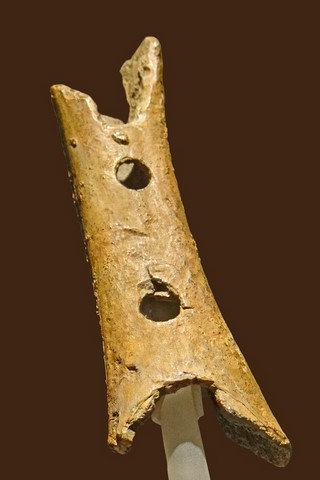
Paleolithic flute (National Museum of Slovenia, Ljubljana) (9420310527).
Image credit: dalbera from Paris, France - Flûte paléolithique (musée national de Slovénie, Ljubljana) - Uploaded by sporti, 2013, CC BY 2.0.
https://en.wikipedia.org/wiki/Divje_Babe_Flute
See also: Q-Mag: The Ice Age Flute
Thus, Palaeolothic people used echolocation (spots of maximum resonance where voice was amplified and clear, plus spots which sounded very similar to the animals painted on the walls nearby) and their ritual artistic systems included both painting and singing (music) like being in ‘concert halls’. This concept continued into the Bronze Age, as The Vallée des Merveilles (aka Valle delle Meraviglie or Valley of Marvels) See also: Q-Mag: The petroglyphs of Mount Bégo - part of the Mercantour National Park in Southern France - proves. The area holds the largest quantity of open-air Bronze Age petroglyphs in Europe, after Val Camonica in Italy, and by the lake, the echo answers whole melodies and it is a pleasure to sing or play at this place (Lewis-Williams, 2004; Hale, 2007; Reznikoff, 2014). Finally, the rocks in the caves, just as other landscape and human-made formations, have sound healing properties. Never forget, also that all crystals/minerals/ rocks/gemstones vibrate in their own individual frequencies, their matrixes following the patterning of Sacred Geometry (<http://www.landscape-perception.com/archaeoacoustics/> and <http://www.landscape-perception.com/links/>; <http://www.ancient-origins.net/ancient-places-africa-opinion/great-pyramid-giza-monument-creation-part-3-air-element-00565>;
<https://www.theguardian.com/culture/shortcuts/2014/mar/05/stonehenge-built-rock-music-bluestones-acoustic>; <http://www.viewzone.com/archeosoundx.html>; <https://www.theatlantic.com/technology/archive/2016/02/byzantine-angel-wings/470076/>; <http://popular-archaeology.com/issue/march-2012/article/ancient-builders-created-monumental-structures-that-altered-sound-and-mind-say-researchers>; <http://www.orkneyjar.com/history/tombs/tombacoustics.htm>).
As Laoupi (2017) points out, ancient humans had knowledge and use of unseen powers, forces and energy fields. There is no question that the EM Spectrum is a naturally occurring part of our environment, comprised of a continuous sequence of electromagnetic energy arranged according to wavelength or frequency, as generated by particle motion (vibrations) and pulses created from many sources. There is also no doubt that many ancient cultures had a connection with Nature and natural forces that was fundamental and could only be described as intimate and profound in ways we moderns can merely attempt to comprehend. Electromagnetic radiation has been around since the birth of the universe; light is its most familiar form. Electric and magnetic fields are part of the spectrum of electromagnetic radiation, which extends from static electric and magnetic fields, through radio frequency and infrared radiation, to X-rays.
Turning his attention to the ancient temples of Malta, Slovakian researcher Dr. Pavel Smutny explains that complexes were used probably as generators of high frequency acoustic waves. Purposes were (maybe) to arrange a communication channel among various islands. Legends abound around Malta of sirens (acoustically) tempting or deafening seafarers. Illustrations show the similarities of the Hagar Qim Temple compound layout on Malta when compared to a typical 800 MHz wireless antenna pattern. There are an infinite variety of patterns that can be generated by antennas depending on the beam width desired, distance between the antenna poles and the frequency being transmitted. However, nearly all antenna patterns have similar characteristics consisting of a main beam lobe and side lobes as well as nulls and a back lobe. ‘Lobe’ was a word Graham Hancock (https://grahamhancock.com/ kreisbergg6/) specifically used to describe the temple structures on Malta, mentioning the unusual acoustics he encountered in the Hypogeum on Malta. Even more, the visual impacts related to Cymatics or energy patterns, may also be observed in the case of Stonehenge monuments resembling the symbol of the labyrinth (Kreisberg, 2010; Eneix and Zubrow, 2014). Thus, Sirens could be the symbol of electromagnetic waves of sound that travel as birds in Nature and the Labyrinth, the symbol of the human brain.
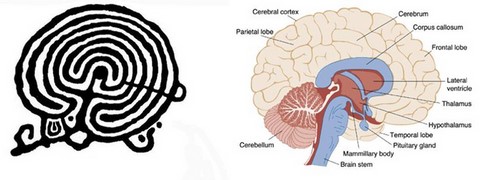
Left: Labyrinth petroglyph from Pedra do Labirinto, Galicia. Dated to ca 2000 BCE (perhaps 750–500 BCE); Saward, 2003, 38. Right: The human brain. Image synthesis by Amanda Laoupi
Conclusions
The influence of environmental chemical elements on the processes of hominization and encephalisation had been started long before historic times. For the past fifteen million years, the East African Rift Valley has been a unique geological environment which contained volcanic activity and many enormous freshwater lakes. Paleoanthropological evidence clearly indicates that hominids evolved in East Africa, and that early Homo inhabited the Rift Valley lake shores. Although earlier hominid species migrated to Eurasia, modern Homo sapiens is believed to have originated in Africa and subsequently migrated throughout the world. The nutrient-rich volcanic landscapes had a crucial impact on the shift in the hominid resource base; this was accompanied by an increase in relative brain size and a shift towards modern patterns of foetal and infant development.
Just like calcium & oxygen, iodine is contained in the Earth's crust and the oceans. Iodine follows a cycle leading it to the sphere’s surface. The morphological and physiological role of iodine in organisms is significant. Iodine influence on the development or regression of caudal or cerebral tissues is well-known. The thyroid hormone acts on almost all tissues but with more effectiveness on bone and nervous tissues. Brain development claims higher amounts. So that volcanic and shore (near bodies of water) environments, rich in brain selective minerals, were always highly attractive to humans, all over the world, counterbalancing any danger and disaster.
In open land environments, a series of biogenetic parameters played also a crucial role in the Neanderthals’ survival under extremely harsh conditions for thousands of years. Modern researchers have isolated the genes which were expressed as various characteristics that helped humans to survive. It is noteworthy that many of those genes have been passed through the Homo sapiens genome, some of them being positive to our evolution, some of them causing problems due to different environmental and daily conditions and parallel mutations over the centuries.
On the other hand, the caves hold a prominent position in the mythology, cult and daily life of past human communities. Their deep dual symbolism ranges from idyllic sceneries and wombs of birth to dens for monsters and chthonic creatures, creating unique cultural landscapes that need protection, management and integration into the heritage agenda of modern societies. Life and death, light and dark, rejection and healing, Eros and Mania, inspiration and terror, are the Janus’ face of the archetypal cave. Ceremonies and celebrations took place within them, asking for protection, abundance, wealth, power, divine revelation and prophecies. Their environments provided humans a protecting shield against microbes and infections.
All human senses benefited from cave environments as research has shown.
The Eternal Embrace
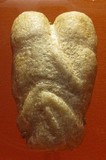
Articles in Q-MAG.org
Cyprus salt lakes exonerate Peoples of the Sea from destroying Bronze Age civilizations
Toppling Rome's obelisks and aqueducts
Trevor Palmer's response to Gunnar Heinsohn
Jan Beaufort: Conspiracy or religious history?
Gunnar Heinsohn's answer to Trevor Palmer
G.H.: Vikings without towns, ports and sails...
Trevor Palmer challenges Gunnar Heinsohn
The 1st Millennium AD controversy
The exact dates of the deaths of Patroclus and Hector
Lybian rock-art erased by Jihadists
The tsunami that obliterated Doggerland
Miles below ground, live the creatures of the Deep
Navigation systems of migratory birds suffer from electromagnetic fields
G.H.: Charlemagne's correct place in history
The petroglyph sundial of Mount Bégo
Mount Bégo: an electrical mountain

